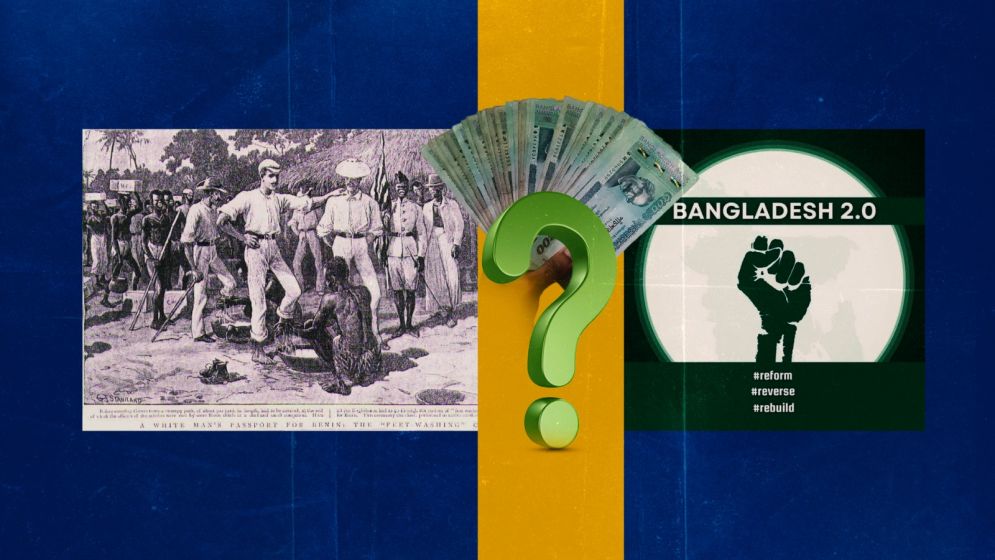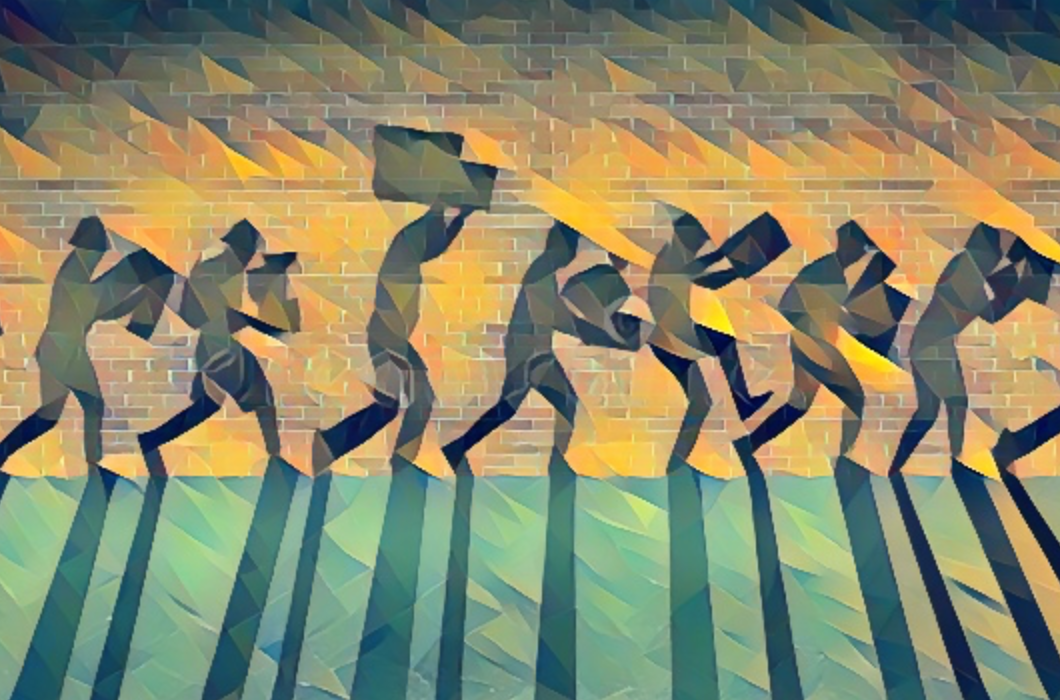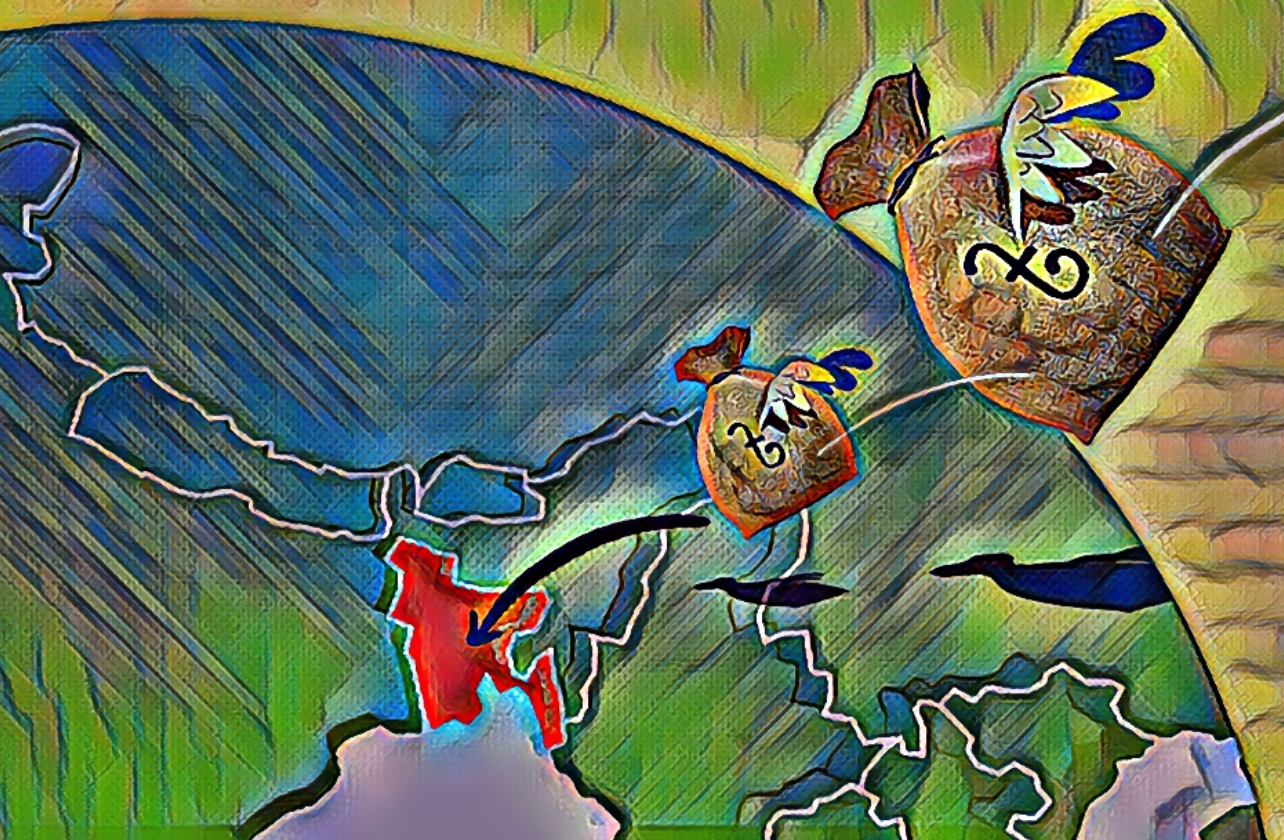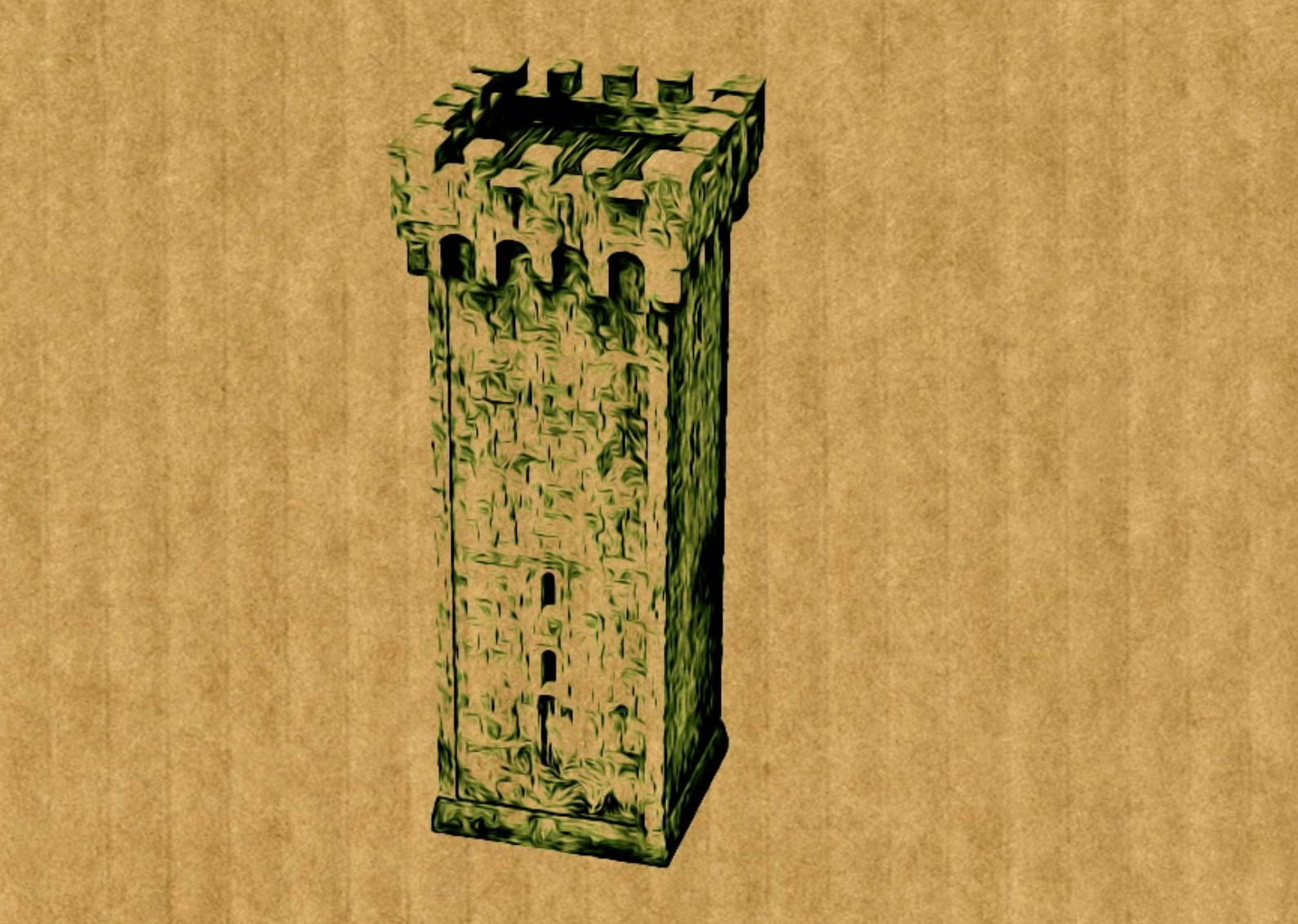From empire to oligarchy: Can Bangladesh break the cycle of elite plunder?

Colonialism never really left South Asia—it simply changed hands.
Under British rule, exploitation in Bengal was neither accidental nor chaotic. It was engineered with brutal efficiency.
In 1793, the Permanent Settlement Act rewrote land ownership in East Bengal, granting hereditary rights to Zamindars, many of whom were Bengali Hindus, to serve as the enforcers of British economic interests.
Unlike the Mughals, whose land system allowed for state oversight and taxation based on actual agricultural yield, the British imposed fixed taxes, indifferent to harvest conditions.
The result: a catastrophic squeeze on Muslim and Hindu peasants alike, forced to feed an imperial machine designed to extract wealth and break local resilience.
Around 80% of the Zamindars in East Bengal fell into this new comprador class. They became the frontline agents of colonial extraction—ruthless in their collections, detached from the suffering of the land they claimed to rule.
The Muslim peasantry, in particular, bore the brunt of this violence. Resistance followed, fierce and prolonged. Movements like the Faraizi rebellion of the mid-19th century emerged as early articulations of class and religious revolt against not just colonialism, but its local collaborators.
And when the British grip began to falter, these Zamindars didn’t stay to defend the lands they claimed to own—they fled, retreating to Kolkata and leaving behind a legacy of feudal devastation.
But independence brought no clean break.
In post-1947 Pakistan, the old class hierarchies were simply repackaged. Power shifted from Kolkata’s palatial mansions to Karachi’s boardrooms. During the military-industrial boom of Ayub Khan’s regime, a new elite emerged—the infamous “22 Families.”
In a damning 1968 speech, Dr. Mahbub ul Haq revealed that these families controlled over two-thirds of Pakistan’s industrial wealth, most of its banking assets, and nearly all of its insurance sector.
Names like Adamjee, Saigol, Dawood, and Isphani became synonymous with state-sponsored profiteering.
In East Pakistan, now Bangladesh, this economic colonization sparked outrage. While West Pakistani families enriched themselves through centralized planning and military favoritism, the people of East Bengal were left with hunger, repression, and disenfranchisement.
This economic apartheid was not peripheral—it was central to the eruption of the Liberation War in 1971.
But if Bangladesh’s independence was meant to mark the end of elite dominance, history had other plans.

A
new power class
After 1971, a new class of insiders moved swiftly to fill the vacuum left by retreating West Pakistani capitalists. Armed with revolutionary credibility and political proximity to exiled leadership, they carved up the spoils of a shattered state.
Nationalized industries became personal empires. Prime real estate in Gulshan and Banani—once the colonial outskirts—became symbols of inherited privilege repackaged as patriotic success.
Government contracts, foreign aid, and reconstruction licenses were not tools for nation-building but currency in a game of elite consolidation.
This is how the Bangladeshi capitalist class was born—not through innovation or merit, but by appropriating a war of liberation and converting it into capital.
From the landlords of colonial Bengal to the oligarchs of post-independence Dhaka, the cycle of extraction, exclusion, and elite capture has remained alarmingly consistent.
The dream of a just, inclusive Bangladesh did not die with colonialism. It died in the boardrooms, ministries, and private clubs where those with the right connections—and the right slogans—traded in revolution for real estate.
As Bangladesh transitioned into a neoliberal “success story,” its elite found a new frontier: cheap labor.
With an abundant, desperate workforce, they transformed the country into the world’s second-largest exporter of garments and a rising hub for other labor-intensive industries.
But this wasn’t development—it was extraction, cloaked in the language of growth. As profits surged, so too did the political ambitions of the business class. Conglomerates ballooned into economic and political juggernauts, funding campaigns, writing legislation, and all but taking up permanent residence in parliament.
By 2009, under the unbroken rule of the Awami League through 2014, 2018, and again in 2024, these corporations evolved into full-fledged multinationals—some reaching billion-dollar valuations.
But this dazzling ascent was paid for in blood, sweat, and stolen futures. Alongside their meteoric rise came a wave of elite criminality: cartelized suppression of labor unions, tax evasion engineered into law, rampant bank looting, and billions laundered into offshore accounts, real estate in Toronto, second homes in London, and children’s tuitions at Ivy League schools.
Yet even as the top plundered, the country did not collapse—because the bottom held it up.
It was the “boys”—the migrant workers sweating under foreign suns—who kept the economy breathing with remittances.
It was the “girls” in garment factories who powered the export machine that paid for the country’s fuel, food, and medicine. Bangladesh survived on the backs of its working class.
The elite thrived despite them.
And yet, the irony is grotesque. These same elites, speeding past Dhaka’s crumbling infrastructure in imported SUVs, wrinkle their noses at the sight of barefoot rickshaw pullers and decaying apartment blocks.
They feel ashamed of their own country—not because of what they’ve done to it, but because of how “uncivilized” it now looks. For them, home is now Singapore, London, or Washington, D.C. The irony escapes them entirely.
Had they not systematically siphoned off over $16 billion annually for the past 15 years—had they reinvested even a fraction of that wealth into the cities and citizens they drained—perhaps Bangladesh wouldn’t feel so alien to them.
Perhaps those streets would shimmer with dignity, not dust. And perhaps the working poor would have had more than just survival—they might have had pride.
Then came 2024.

An
unexpected yet long due uprising
The student uprising against discrimination in government hiring did not come from nowhere.
It was merely the latest tremor in a long, unfinished earthquake. From the peasant revolts against colonial zamindars, to the language martyrs of 1952, to the Liberation War of 1971, the core demand has always been the same: inclusion. Justice. A voice.
But this time, the uprising struck deeper because it was not alone. It was powered by a new and formidable ally: the diaspora labor force.
In a coordinated act of economic defiance, overseas workers halted remittances—the very currency that had kept the regime afloat.
It was a masterstroke. A nonviolent, precision strike against a government that had long treated them as ATMs with no voting rights.
Their silence was louder than any street protest. And it worked.
Just as the Faraizi movement weakened British rule, and just as economic exclusion catalyzed 1971, the remittance strike of 2024 was not just an act of solidarity—it was a turning point.
A working-class, transnational revolution against elite impunity.
It reminded the nation of a truth its ruling class has tried desperately to bury: that the people who build and sustain a country are not the ones in parliament or boardrooms. They’re the ones who sweat, bleed, and send money home.
Even if the events of August 5th—the dramatic collapse of the regime—had not unfolded, Bangladesh was already hurtling toward economic breakdown.
The warning signs weren’t subtle. The World Bank projects the country’s GDP growth to fall to its lowest point in 36 years, with at least 3 million more people expected to slip into poverty.
This isn’t the aftermath of revolution—it’s the legacy of decades of unchecked corruption, kleptocracy, and economic cannibalism by a political-business nexus that hollowed out the nation from the inside.
And yet, as always, it is the wage earners—the nameless millions working in Middle Eastern deserts, European kitchens, and Southeast Asian docks—who are still keeping the nation on life support.
Even amid political chaos and collapsing confidence, they continued to send money home, helping the country narrowly avoid the kind of famine Sheikh Hasina herself once warned about in relation to the Russia-Ukraine war.
They are the last line of defense. The invisible foundation holding up a crumbling state.
Now, in the wake of the July–August revolution—a revolt ignited, led, and carried to victory by Gen Z—we stand at a dangerous but promising crossroads. What began as a digital-age rebellion by students and young workers quickly expanded beyond the predictable demographics.
The movement unexpectedly drew in sons and daughters of the elite, prompting a question that still lingers in the air: Did these privileged youth rise up out of genuine outrage at inequality, or was this just rebellion as a fashion statement?
Either way, the effect is undeniable. Their involvement has struck a blow deep within elite households. Parents—once comfortable in their power, their silence, their gated communities—are now confronted with the rebellion of their own blood.
They must now decide: Will they embrace this generational rupture and accept that change is erupting from within? Or will they drag their children back into the oligarchic mold that enriched their ancestors?
This is no small question. The disenfranchised majority is no longer quiet. They are no longer invisible. And they are not going away.

The
tower and the square
Just this past week, Nobel Laureate Professor Muhammad Yunus expressed cautious support for the Interim Government, noting that many in the country—particularly the working class—were beginning to feel some tangible relief.
In response, opposition leader Mirza Fakhrul, sounding increasingly out of touch, scoffed: “Which people is Professor Yunus referring to?”
The answer should be obvious: the working poor. The same people Fakhrul and his allies have long ignored—except when mobilizing them for rallies or using them as rhetorical props in calls for elections.
Professor Yunus has made it clear that his vision of “social business” is not a theory. It is, for many at the bottom of society, becoming a lived reality. Micro-credits, rural clinics, and small-scale cooperatives are beginning to improve lives in measurable ways.
Mirza Fakhrul and the political class he represents, however, are desperate to return to the "old normal."
Their opposition to reforms, couched in the language of constitutionalism and electoral urgency, is less about democracy than about restoring a system that reliably served elite interests.
The real panic is not on the streets—it’s in the private lounges and club bars where Bangladesh’s oligarchs now whisper: the business environment is becoming “unfriendly.”
What they really mean is that regulations are being enforced. Tax evasion is harder. Corrupt officials are no longer picking up the phone. The monopolies they built through backroom deals and regulatory capture are, for the moment, on hold.
In short: the game is no longer rigged in their favor. And that, more than anything, is why they want the system "restored."
But the question now is whether this generation—of young activists, working-class voters, and even elite defectors—will allow that restoration to happen.
It’s not difficult to understand why there is a swelling demand—especially from the long-silenced majority—for Professor Muhammad Yunus, now 84, to remain at the helm for another five years.
And when we say “public demand,” let’s be clear: we’re not talking about corporate boardrooms, diplomatic cocktail circuits, or the echo chambers of political dynasties.
We’re talking about the people who have borne the weight of structural discrimination since 1793—the farmers and factory workers, the migrants and mothers, the remittance senders and the rent payers.
The people who’ve watched the nation be auctioned off piece by piece to those who speak of patriotism while laundering its wealth abroad.

Can
we capitalize on the turning point?
Professor Yunus, in nearly every recent interview, has framed 2024 not merely as a political moment, but as a civilizational turning point.
He’s right. At the heart of his vision is a demand that this country finally confront a centuries-old injustice: the legacy of the Permanent Settlement Act, which transferred land and power into the hands of a colonial-aligned elite and pushed the majority—largely Bengali Muslims—into generational marginalization.
That same logic of exclusion has shapeshifted over time, from British zamindars to Pakistani industrialists to today’s local oligarchs. The faces have changed. The exploitation hasn’t.
Yunus’s call is simple but radical: break the cycle. Redesign the architecture of power. Build a society where dignity is not a luxury, and citizenship is not a birthright of the rich.
His critics say he’s old, out of touch, idealistic.
But if the alternative is the same revolving door of elites, of men who view justice as a threat and regulation as tyranny, then maybe age is not the liability—it’s the asset.
Maybe a man who has spent his life trying to empower the poor is precisely the kind of leadership we need now, as we stare down the consequences of decades of elite-driven ruin.
And here’s the uncomfortable question we all have to ask ourselves now: In this defining moment—when the exploited are rising and the exploiters are scrambling—whose side are we really on?
Not in theory. Not in social media posts. But in truth. In action.
Because the next generation is watching. And they will ask: When the chance finally came to choose justice, did you take it?
Or did you stay silent, again?
—-
Arif Hafiz is a political analyst, cultural critic, and independent columnist.

